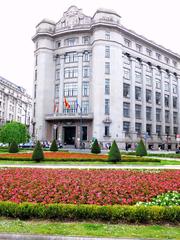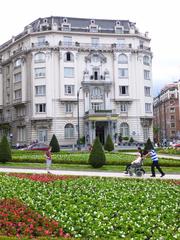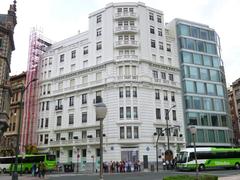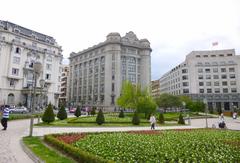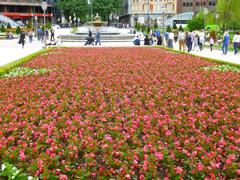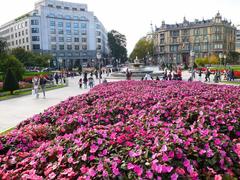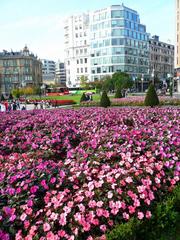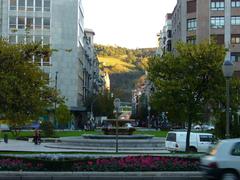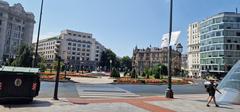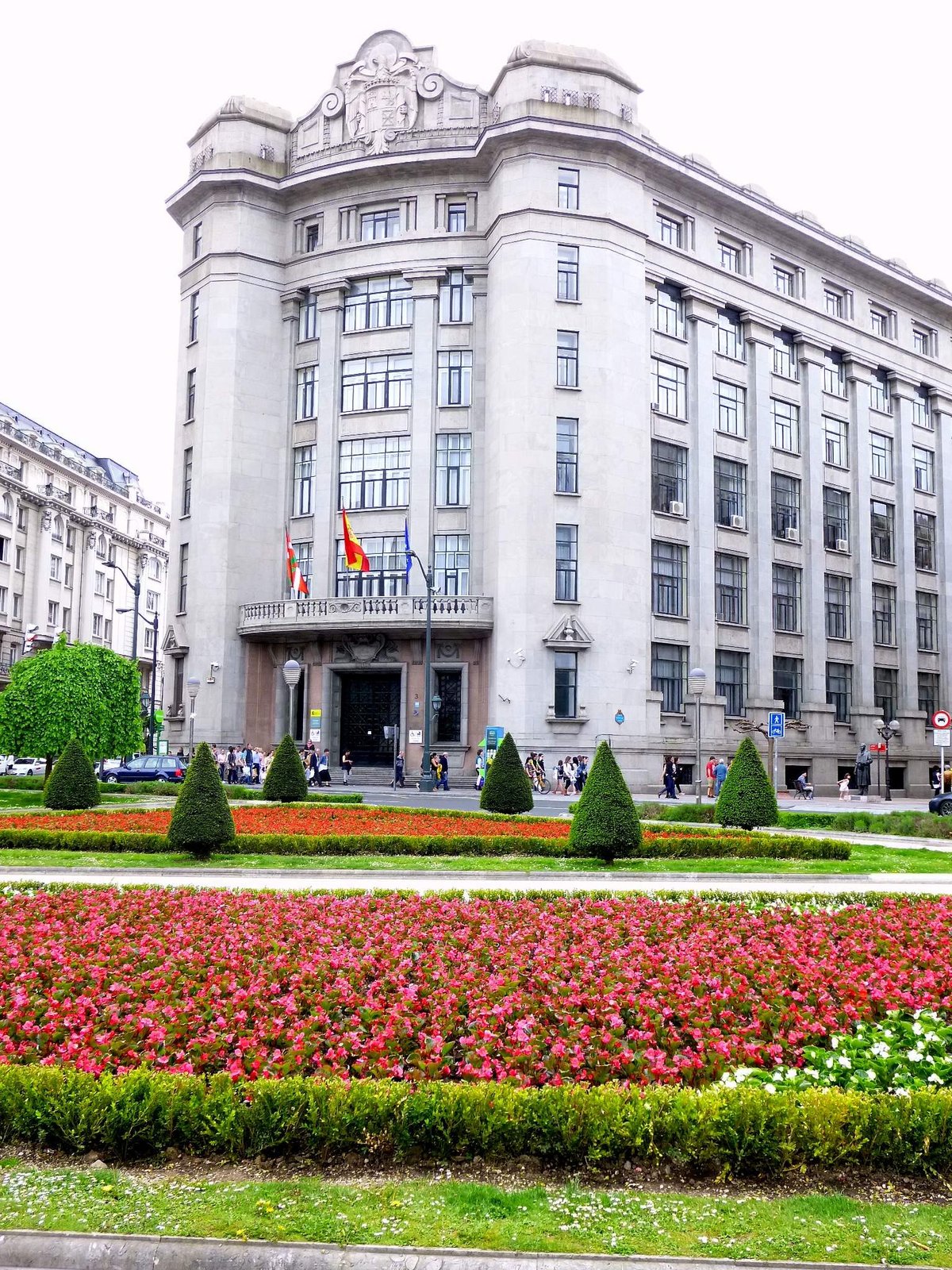
Plaza Moyúa Bilbao: Visiting Hours, Tickets, and Travel Guide
Date: 14/06/2025
Introduction
Plaza Moyúa, also known as Plaza Elíptica or Plaza de Federico Moyúa, is a distinguished urban landmark at the heart of Bilbao, Spain. This elegant elliptical plaza epitomizes the city’s rich historical heritage and dynamic contemporary culture. Born from Bilbao’s late 19th-century urban expansion, Plaza Moyúa stands today as both a symbol of civic pride and a vibrant hub for social, cultural, and commercial activity (Wikipedia; Barceló Guide).
This guide provides an in-depth look at the plaza’s history, cultural significance, architectural highlights, visitor information, nearby attractions, and practical tips to help you make the most of your visit to this iconic Bilbao destination.
Table of Contents
- Historical Background
- Architectural Highlights
- Urban Transformation and Modernization
- Visiting Information
- Nearby Attractions
- Cultural and Social Significance
- Events and Local Customs
- Accessibility and Transport
- Travel Tips
- FAQ
- Conclusion
- References
Historical Background
Origins and Urban Planning
Plaza Moyúa was conceived in 1876 as a focal point of Bilbao’s ambitious Ensanche (urban extension) project, a master plan designed to propel the city into modernity during the height of its industrial boom (Wikipedia; Kaczmarska, 2017). Its elliptical form and radiating streets were intended to serve as both a geometric and symbolic center for the city’s new district (Barceló Guide).
Construction and Architectural Evolution
The current configuration of Plaza Moyúa took shape in the 1940s under architect José Luis Salinas. The elegant design features meticulously landscaped English and French-style gardens, a central fountain, and is encircled by some of Bilbao’s most notable buildings (Bilbao Turismo). Notable structures include the neo-Flemish Palacio Chávarri, the Belle Époque Hotel Carlton, and the modernist Casa Montero, all of which highlight Bilbao’s architectural diversity (Bizkaia Guide).
Architectural Highlights
Plaza Moyúa’s urban layout is defined by its elliptical shape, radiating avenues, and beautifully maintained gardens. Among its architectural treasures:
- Hotel Carlton: A Belle Époque masterpiece built in 1926, renowned for its grand façade and historical significance, including serving as the Basque government headquarters during the Spanish Civil War (Evendo).
- Palacio Chávarri: A striking neo-Flemish building with ornate brickwork, now housing government offices.
- Casa Montero: An example of Bilbao’s modernist architecture, reminiscent of Gaudí’s style.
The central fountain and lush, symmetrical flowerbeds create a tranquil oasis, making the plaza a favorite spot for both relaxation and photography (Bilbao Turismo; GPSmyCity).
Urban Transformation and Modernization
In 1997, the plaza underwent a significant renovation led by Manuel Salinas, the original architect’s son, coinciding with the construction of the Bilbao Metro beneath the square (Wikipedia). The redesign preserved the historical layout and fountain while introducing modern amenities such as steel lampposts and new benches. Today, the Moyúa Metro station (lines 1 and 2) provides seamless access to major city attractions and transport links (Wikipedia).
Visiting Information
Hours and Tickets
- Opening Hours: Plaza Moyúa is open and accessible 24/7.
- Tickets: Entry is free; no tickets are required.
- Best Time to Visit: Spring and summer for vibrant gardens; early morning or late afternoon for optimal photography.
Accessibility
- Wheelchair Access: The plaza and its surroundings are wheelchair-friendly, with smooth paths and step-free access.
- Public Transport: Moyúa Metro station, several bus lines, and nearby tram stops ensure excellent connectivity (Rough Guides).
- Parking: Limited; public transit is recommended for convenience (HikersBay).
Nearby Attractions
- Guggenheim Museum Bilbao: A world-renowned museum of modern art and architecture, 10–15 minutes’ walk away (GetYourGuide).
- Museo de Bellas Artes de Bilbao: Features an impressive collection of European art, just a short walk from the plaza.
- Gran Vía de Don Diego López de Haro: Bilbao’s main commercial avenue, perfect for shopping and people-watching (Full Suitcase).
- Chavarri Palace: A Flemish-inspired government building facing the plaza.
- Casco Viejo (Old Town): A historic quarter with narrow streets, pintxos bars, and lively atmosphere.
- El Corte Inglés: A major department store for shopping and gourmet food.
- Doña Casilda Iturrizar Park: A nearby green space ideal for relaxation.
Cultural and Social Significance
Plaza Moyúa is more than an architectural gem—it’s a living symbol of Bilbao’s identity and transformation. Named after Federico Moyúa, a pivotal mayor in the city’s development, the plaza acts as a meeting point and cultural crossroads for locals and visitors alike (Lonely Planet). It hosts festive markets, public celebrations, and is a starting point for exploring the city’s vibrant social life.
Events and Local Customs
Festivals and Markets
- Christmas Market: The plaza and surrounding Gran Vía come alive with seasonal stalls and festive lights.
- Aste Nagusia: Bilbao’s biggest festival transforms the plaza into a hub for concerts, parades, and fireworks.
Gastronomy
The area is renowned for Basque pintxos bars and restaurants, making it an ideal spot for sampling local cuisine and participating in the “poteo” (bar-hopping) tradition (Hostelworld).
Language
Both Spanish and Basque are spoken. Simple Basque greetings (like “Kaixo” for hello) are appreciated.
Accessibility and Transport
- Metro: Moyúa station (lines 1 and 2) is directly under the plaza.
- Tram: Stops nearby for convenient travel to other key sites.
- Bus: Multiple lines serve the area.
- Cycling: Bike-sharing stations and cycling lanes are available (Full Suitcase).
The plaza is designed for inclusivity, with step-free access and amenities for visitors with reduced mobility.
Travel Tips
- Photography: Visit at sunrise or sunset for the best lighting.
- Safety: The area is clean, well-lit, and considered very safe (HikersBay).
- Shopping: Explore boutiques along Gran Vía and El Corte Inglés.
- Weather: May–September offers mild, pleasant conditions.
- Etiquette: Dress neatly; modest attire is appreciated in public buildings.
FAQ
Q: What are Plaza Moyúa’s visiting hours?
A: The plaza is open 24 hours a day, 7 days a week.
Q: Is there an entrance fee?
A: No, entry is free.
Q: How do I reach Plaza Moyúa by public transport?
A: Take Metro Bilbao (lines 1 or 2) to Moyúa station, or use city bus and tram lines.
Q: Is the plaza accessible for people with reduced mobility?
A: Yes, with smooth pathways and step-free access.
Q: Are guided tours available?
A: Yes, many walking tours of Bilbao include Plaza Moyúa.
Q: What nearby attractions should I visit?
A: The Guggenheim Museum, Museo de Bellas Artes, Chavarri Palace, Gran Vía, and Casco Viejo.
Conclusion
Plaza Moyúa is a quintessential Bilbao experience, combining historical elegance, lush gardens, and vibrant social life. Its central location and excellent transport links make it an ideal starting point for exploring Bilbao’s best attractions. Whether you’re drawn by the architecture, local gastronomy, or the city’s lively cultural calendar, a visit to Plaza Moyúa is sure to be memorable.
Plan your trip with the Audiala app for interactive maps, guided tours, and the latest travel tips. For more inspiration, read our articles on Bilbao’s top museums, Casco Viejo, and Basque pintxos.
Visuals
Alt text: Central fountain at Plaza Moyúa, Bilbao, surrounded by flowerbeds and historic buildings.
Alt text: Aerial photograph showing the elliptical layout of Plaza Moyúa and connecting streets.
Interactive Map of Plaza Moyúa and Nearby Attractions
References
- Barceló Guide
- Bilbao Turismo
- Wikipedia
- Lonely Planet
- Full Suitcase
- Evendo
- Hostelworld
- HikersBay
- Rough Guides
- GetYourGuide
